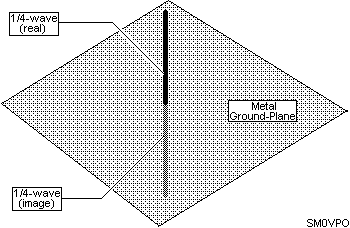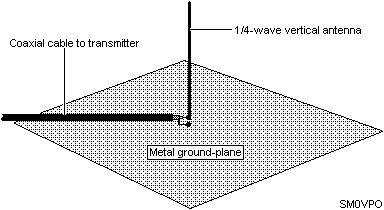

One of the most frequent questions I am asked by E-mail is "how does an antenna work?" and "Why does it have to be a particular length?". This article is designed to answer thse very questions. The information I will present may be a little over simplified for many, but remember that we all had to begin somewhere. In this article I will only be concerned with Metres, so all figures and formulas will be given in metres.

Radio waves composed of both an electrical field and a magnetic field. When we pass a current through a length of wire it radiated a magnetic field and the polarisation of that field is in circles around the wire. There is also an electric field which is polarised along the length of the wire. The speed electricity and magnetism travels is just a little under 300,000,000 metres per second. So if we send an Alternating Current (AC) through the wire then after one second one wave will have travelled 300 million metres. If the frequency of the AC current was 1 cycle per second then each complete cycle would have travelled 300 million metres. Let us just look at the voltage and ignore the current distribution through our long bit of wire.


| Freq (Hertz) | Freq (MHz) | W/L | Band |
|---|---|---|---|
| 3,000 to 30,000 | 3KHz to 30KHz | 100000m to 10000m | Very Low Frequency (VLF) |
| 30,000 to 300,000 | 30KHz to 300KHz | 10000m to 1000m | Low Frequency (LF) |
| 300,000 to 3,000,000 | 300KHz (0.3MHz) to 3MHz | 1000m to 100m | Medium Frequency (MF) |
| 3,000,000 to 30,000,000 | 3MHz to 30MHz | 100m to 10m | High Frequency (HF) |
| 30,000,000 to 300,000,000 | 30MHz to 300MHz | 10m to 1m | Very High Frequency (VHF) |
| 300,000,000 to 3,000,000,000 | 300MHz to 3000MHz (3GHz) | 1m to 10cm | Ultra High Frequency (UHF) |
| 3,000,000,000 to 30,000,000,000 | 3GHz to 30GHz | 10cm to 1cm | Super High Frequency (SHF) |
| 30,000,000,000 upwards | 30GHz upwards | 1cm downwards | F***ing High Frequency (FHF) |
A full wavelength is therefore found by the formula 300/fMHz where fMHz is the radio frequency in meggahertz.

A full wavelength antenna is rarely used for amateur work. We more often than not try to use a 1/2 wavelength, in the centre and fed at the two ends of the cut to a transmitter via a balun (transformer) and feeder. The formula for a 1/2 wavelength is 150/fMHz metres long. The ends of a 1/2-wave antenna are not connected to anything, so there is no current, but there are loads of volts. A the centre of the 1/2-wave there is loads of current, but no volts. This is what it will look like if you could see the voltage waveform on the antenna driven by a transmitter.


When all the power hits the end of the antenna it will be reflected back and as you can see above, the reflected wave will follow the forward wave exactly. It is a fact that the signal radiated is only about 1%, but when the signal bounces back it will radiate another 1%. When it hits the other end it will bounce back again and radiate yet another 1%. In this way the signal will bounce back and forth many hundreds of times. Eventually the signal will be almost totally radiated. Since the reflected matches the forward exactly it will always be in the same phase no-matter how many times it bounces back and forth.
Each bounce (reflection) MUST be in exact phase with all the other reflections and the new signal that is being continuously fed into the antenna. With just one watt of power there will therefore be many watts of of power, possibly hundreds of watts of power, in the antenna at any instant in time. This is known as a Dipole antenna. Incidentally, I think it should be known as a Bipole in exactly the same was as Bicycle, Bisexual, Biannual and Biode!!!
So, what happens if the antenna is NOT to exactly 1/2-wave? Easy! It doesn't work as well. Let us make the antenna just 10% too long. 10% is not much, is it? In reality, a 10% length error will make the antenna a VERY poor performer, possibly only 7% efficient!

When the power hits the end of the wire it's first bounce back has a different phase to the original waveform. The second bounce will be even farther out of phase. The 5th, 6th, and 7th bounces will be so far out of phase that they cancel out the original signal from the transmitter. Remember that the 7th bounce is still about 93% of the original full power level. The graphic representation above shows you what is happening. The bigger the length error so will there be fewer bounces required to get a 100% cancellation.
Now I hope that you get the idea that an antenna that is just 5% too long or short can have a very much reduced radiation property. Since the signal is bouncing back and forth it is also oscillating, just like in a capacitor/inductor tuned circuit, this is because the antenna IS a tuned circuit.

A half-wave antenna is therefore two quarter-waves mounted end-to-end. Now let us take away one of these quarter-waves and put a metal plate there instead. I will also ratate it so the remaining 1/4-wave element is pointing upwards. The diameter of the tin-plate is assumed to be more than 1/2-wave. When you are looking down on the antenna and plate from the sky you will see something like this:

As you can see, you can see a reflection of the antenna in the tin-plate, and the reflection is pointing down. We can see in this mirror surface a half-wave antenna although half of it is missing. A signal radiated from the antenna will also be reflected in exactly the same way. In other words, instead of using a 1/2-wave antenna we can push our luck and do-away with half of the antenna completely. The metal ground-plane could be any old lump of metal, as long as it is big enough. It could even be the Earth itself, as it is commonly used at HF. This type of antenna is known as a Ground Plane antenna. It is not as efficient as a 1/2-wave antenna since the groundplane is only acting as a big sponge for the other half of the current that is not going up the antenna.

Like this:

The 1/4-wave antenna is therefore perfect for feeding from a commercial Ham-radio transmitter with a coaxial output socket. VHF 1/4-wave antennas also fit well on car roofs and other lands of metal, making loads of money for the sellers of the usual magnetic-mount antenna bases.

Look at my homepages and find the two VSWR projects. These two projects use a bridge circuit to measure the Voltage Standing Wave Ratio (VSWR). This bridge is connected in the fedder cable between the transmitter and the antenna. The object is to get a 1:1 VSWR. The VSWR can be calculated by measuring the forward voltage fed to the antenna and the voltage of signal returning out of phase. To calculate you use the formula:

For example, if you have one watt at 50-ohms impedance fed to an antenna and there is absolutely no measured reflected power, then the forward voltage will be 7-volts. (7 + 0) / (7 - 0) = 1 so the VSWR in this example is 1:1 (perfect). If the reflected power was 500mW then we would have 7-volts forwards and 5-volts reflected from the antenna and (7 + 5) / (7 - 5) = 12 / 2 = 6 or a VSWR of 6:1 which is rather poor, useless, in fact :-(

We have assumed that wire is a 100% perfect conductor, it is not! There are no external influences on the antenna, there are! There are no other factors to be taken into account, there are! In other words, it is time to digest the above then take a trip to your local reference library. Alternatively, get a few bits of wire, make yourself a VSWR bridge and connect your CB set into it. Experiment and learn. The above article is only an introduction. Go take a look at the other antennas on my homepages and apply all the above information to them. The antennas on the pages all work well.

Best regards from Harry - SM0VPO
Return to INFO page